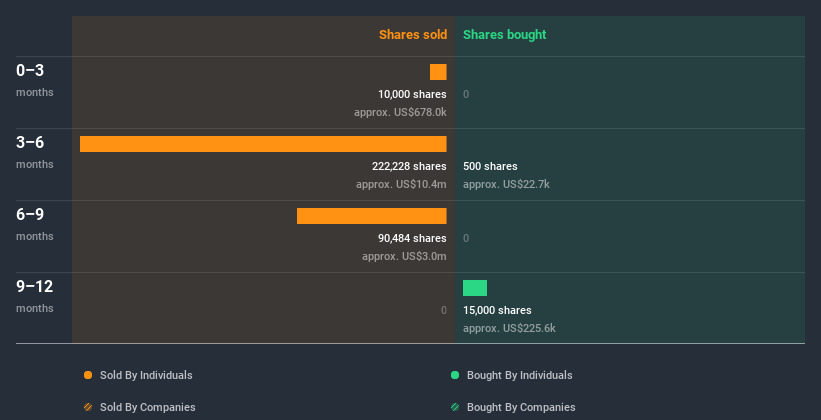We wouldn't blame Darling Ingredients Inc. (NYSE:DAR) shareholders if they were a little worried about the fact that John Muse, the Executive VP & Chief Administrative Officer recently netted about US$678k selling shares at an average price of US$67.80. However, it's crucial to note that they remain very much invested in the stock and that sale only reduced their holding by 9.1%.
Darling Ingredients Insider Transactions Over The Last Year
In the last twelve months, the biggest single sale by an insider was when the Executive VP of Specialty Ingredients & Chief Strategy Officer, John Bullock, sold US$3.4m worth of shares at a price of US$45.79 per share. So it's clear an insider wanted to take some cash off the table, even below the current price of US$78.52. When an insider sells below the current price, it suggests that they considered that lower price to be fair. That makes us wonder what they think of the (higher) recent valuation. While insider selling is not a positive sign, we can't be sure if it does mean insiders think the shares are fully valued, so it's only a weak sign. This single sale was just 35% of John Bullock's stake.
Happily, we note that in the last year insiders paid US$220k for 15.50k shares. But they sold 322.71k shares for US$14m. In total, Darling Ingredients insiders sold more than they bought over the last year. The sellers received a price of around US$43.09, on average. It's not too encouraging to see that insiders have sold at below the current price. Of course, the sales could be motivated for a multitude of reasons, so we shouldn't jump to conclusions. You can see the insider transactions (by companies and individuals) over the last year depicted in the chart below. If you want to know exactly who sold, for how much, and when, simply click on the graph below!

I will like Darling Ingredients better if I see some big insider buys. While we wait, check out this free list of growing companies with considerable, recent, insider buying.
Insider Ownership
Many investors like to check how much of a company is owned by insiders. We usually like to see fairly high levels of insider ownership. It's great to see that Darling Ingredients insiders own 1.3% of the company, worth about US$155m. This kind of significant ownership by insiders does generally increase the chance that the company is run in the interest of all shareholders.
So What Does This Data Suggest About Darling Ingredients Insiders?
An insider hasn't bought Darling Ingredients stock in the last three months, but there was some selling. And our longer term analysis of insider transactions didn't bring confidence, either. While insiders do own a lot of shares in the company (which is good), our analysis of their transactions doesn't make us feel confident about the company. So these insider transactions can help us build a thesis about the stock, but it's also worthwhile knowing the risks facing this company. For instance, we've identified 3 warning signs for Darling Ingredients (1 is concerning) you should be aware of.
But note: Darling Ingredients may not be the best stock to buy. So take a peek at this free list of interesting companies with high ROE and low debt.
For the purposes of this article, insiders are those individuals who report their transactions to the relevant regulatory body. We currently account for open market transactions and private dispositions, but not derivative transactions.
This article by Simply Wall St is general in nature. It does not constitute a recommendation to buy or sell any stock, and does not take account of your objectives, or your financial situation. We aim to bring you long-term focused analysis driven by fundamental data. Note that our analysis may not factor in the latest price-sensitive company announcements or qualitative material. Simply Wall St has no position in any stocks mentioned.
Have feedback on this article? Concerned about the content? Get in touch with us directly. Alternatively, email editorial-team (at) simplywallst.com.
The views and opinions expressed herein are the views and opinions of the author and do not necessarily reflect those of Nasdaq, Inc.


